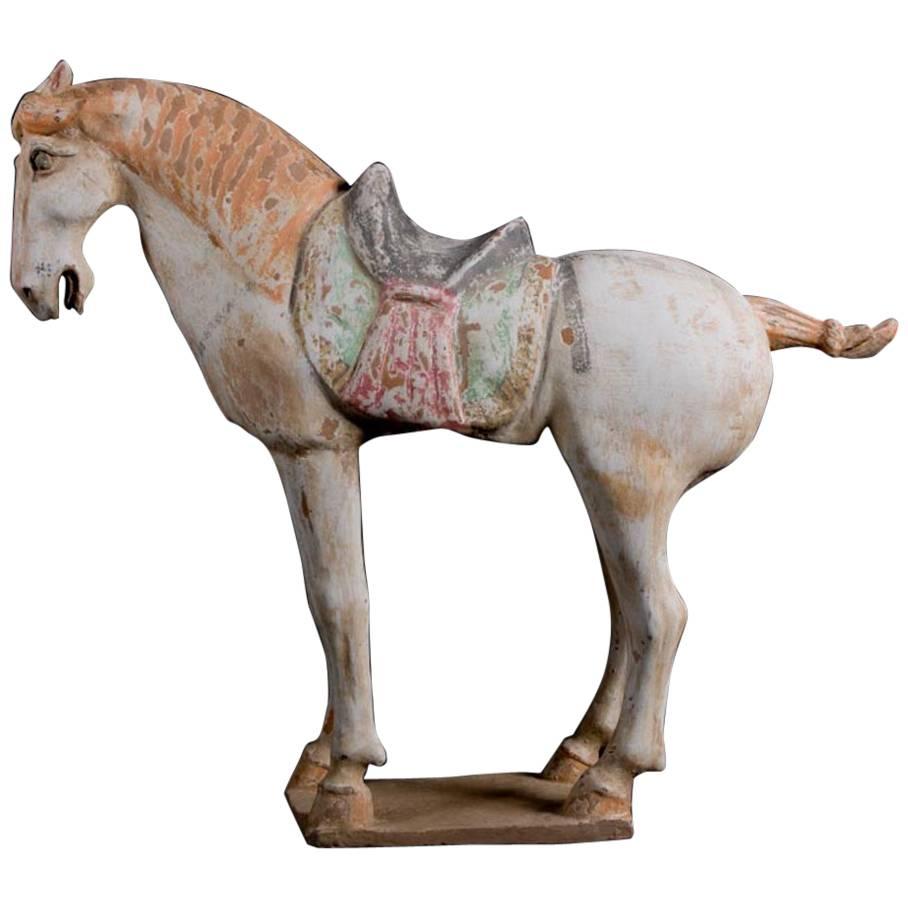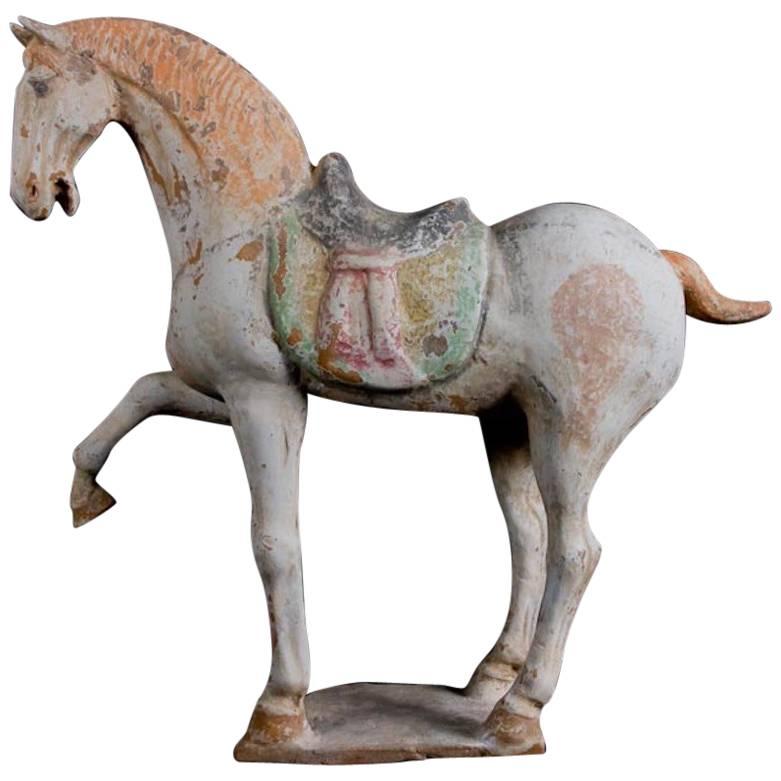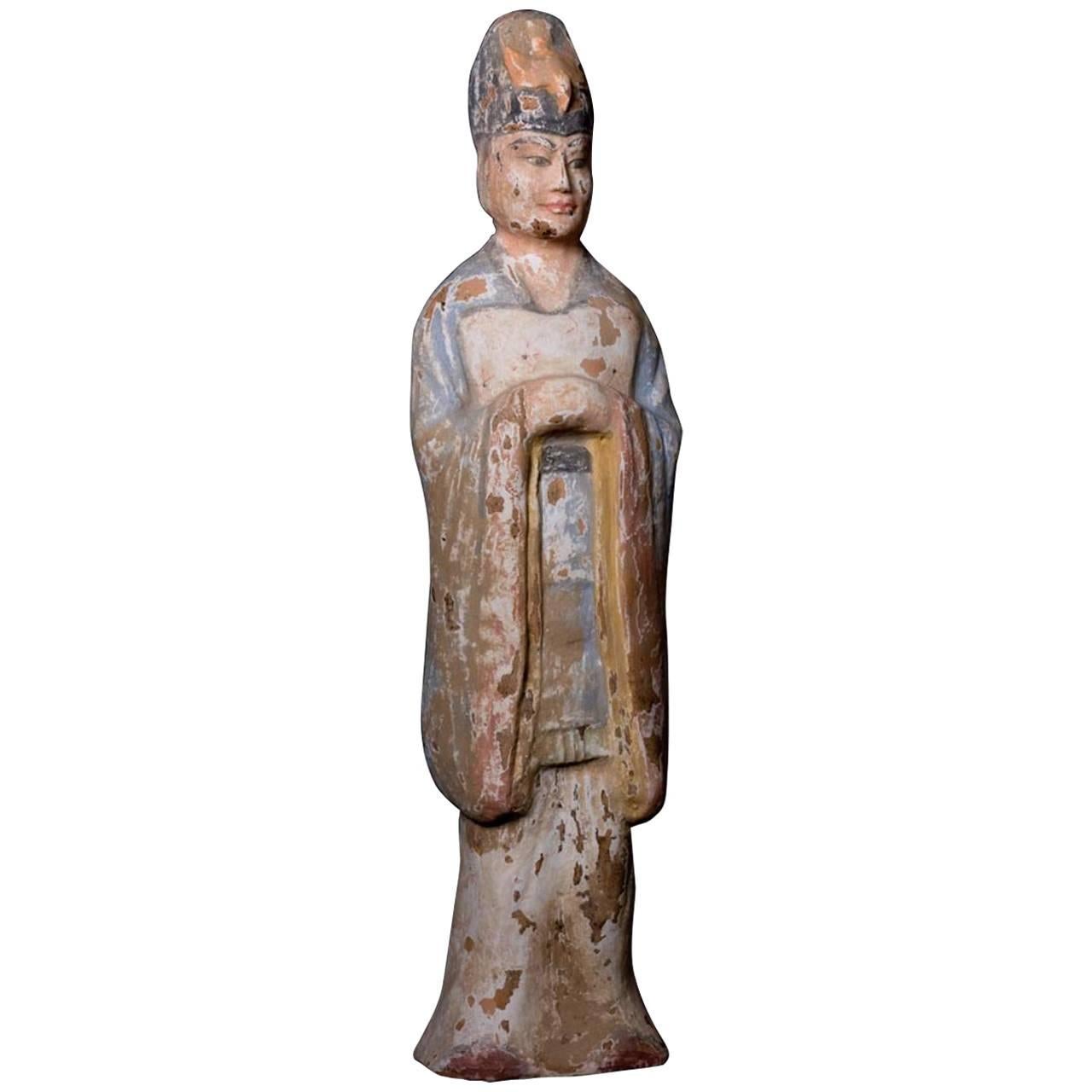Items Similar to Tang Dynasty Court Official in Sancai Glazed Robes, China '618-907' - TL Tested
Want more images or videos?
Request additional images or videos from the seller
1 of 12
Tang Dynasty Court Official in Sancai Glazed Robes, China '618-907' - TL Tested
About the Item
A Tang dynasty sancai (three color) glazed pottery model of a Taoist official, TL tested by Ralf Kotalla - worldwide oldest private laboratory specialized for genuine thermoluminescence test analysis in Germany.
The figure is portrayed standing upon a pedestal in an observant position, dressed in traditional sancai (amber, green, and a creamy off-white) glazed robes, typical of this epoch. His clasped hands are joined in front beneath his long sleeves.
This figure bears the typical headdress for an official in the Tang dynasty and can be identified by the shape of his hat, traces of red pigment can still be observed. The phoenix that decorates his head indicates that he serves in the court of the great immortal Xiwangmu - the Queen Mother of the West - who presides over the Western paradise (the Taoist heaven), a land of eternal summer, perfection, and beauty.
This fantastic piece is accompanied by the following documents:
- TL Test by Ralf Kotalla Laboratory NE: 06081204
- Certificate of Expertise by Jean-Yves Nathan - a leading authority specialized in Far East Archaeology from the CEDEA (The European Confederation of Art Experts).
- European Passport
- Certificate of Authenticity
Provenance: Private European Collection
Taoism is a Chinese philosophy based on the writings of Lao-tzu advocating humility and religious piety. It is a highly organized system, with levels of heaven and hell organized like a bureaucracy, complete with kings, governors, judges and government officials. The Tao - which literally translates as “The Way” - is a fundamental idea in most Chinese philosophical schools; in Taoism, however, it denotes the principle that is the source, pattern and substance of everything that exists.
Burial figurines of graceful dancers, mystical beasts, and everyday objects reveal both how people in early China approached death and how they lived. Since people viewed the afterlife as an extension of worldly life, these figurines, called mingqi, sometimes referred as “spirit utensils” or “vessels of ghosts” disclose details of routine existence and provide insights into belief systems over a thousand-year period.
When China was unified again, first briefly under the Sui and then under the long and prosperous Tang, mingqi truly resurged as a part of elaborate tombs. Tang mingqi integrated the guardian figures and pack animals of the Northern and Southern Dynasties, but also incorporated the many international influences that were popular during this time of stability and expansion. Following Han dynasty traditions, Tang mingqi frequently take the form of musicians, dancers, and servants in clay, but are ornamented with sancai (three-color) glaze, an artistic influence that was transmitted from Central Asia along the Silk Road. Foreigners were also frequently depicted, reflecting a cosmopolitan society that embraced exchanges with other groups and cultures.
- Dimensions:Height: 29 in (73.66 cm)Width: 7 in (17.78 cm)Depth: 6.5 in (16.51 cm)
- Style:Tang (Of the Period)
- Materials and Techniques:Terracotta,Glazed
- Place of Origin:
- Period:
- Date of Manufacture:618-907 AD
- Condition:Wear consistent with age and use. Weight: 11.7 lbs (5.3 kg).
- Seller Location:San Pedro Garza Garcia, MX
- Reference Number:
About the Seller
3.7
Vetted Seller
These experienced sellers undergo a comprehensive evaluation by our team of in-house experts.
1stDibs seller since 2017
22 sales on 1stDibs
Typical response time: 18 hours
- ShippingRetrieving quote...Ships From: Laredo, TX
- Return PolicyA return for this item may be initiated within 3 days of delivery.
More From This SellerView All
- Stunning Terracotta Standing Horse, Tang Dynasty, China '618-907 AD', TL TestLocated in San Pedro Garza Garcia, Nuevo LeonMagnificent standing horse in orange terracotta and traces of painting. With a finely decorated saddle and with the mane and tail hair braided. TL Test by Ralph Kotalla Lab NE: 09K12...Category
Antique 15th Century and Earlier Chinese Tang Antiquities
MaterialsTerracotta
- Majestic Prancing Horse, Tang Dynasty, China '618-907 AD', TL Test by KotallaLocated in San Pedro Garza Garcia, Nuevo LeonMagnificent prancing horse in orange terracotta with traces of polychrome paint. Springing its right leg with a lively position and an expressive look. With a finely decorated saddle...Category
Antique 15th Century and Earlier Chinese Tang Antiquities
MaterialsTerracotta
- Very Elegant Tang Dynasty Dignitary in Orange Terracotta, China '618-907 AD'Located in San Pedro Garza Garcia, Nuevo LeonVery elegant terracotta dignitary in blue and red robes standing with the hands joined at the chest. He wears a blue headdress with a bird at its center. Orange Terracotta This gorg...Category
Antique 15th Century and Earlier Chinese Tang Antiquities
MaterialsTerracotta
- Chimera (Pixiu) Terracotta Mythological Being - Tang Dynasty, China '618-907 AD'Located in San Pedro Garza Garcia, Nuevo LeonMagnificent Mythological Being "Chimera" with Human Face and Flaming Rays Halo. Orange Terracotta with Traces of Stucco and Painting. This creature is commonly known as Pixiu. Fierc...Category
Antique 15th Century and Earlier Chinese Tang Antiquities
MaterialsTerracotta
- Monumental Buddha Torso White Marble Sculpture - Tang Dynasty China 618-907 ADLocated in San Pedro Garza Garcia, Nuevo LeonBeautiful and impressive early Tang white marble sculpture of headless Buddha, dressed in an elegant pleated toga. China. 618-907 AD. A true collectors piece. This magnificent piece...Category
Antique 15th Century and Earlier Chinese Tang Antiquities
MaterialsMarble
- Tang Dynasty Imposing Terracota Lokapala Standing in Menacing Pose - TL TestedLocated in San Pedro Garza Garcia, Nuevo LeonImposing Lokapala figure standing in menacing pose. Terracotta with traces of old color pigments. China, Tang dynasty (618-907 AD.) Museum piece. Lokapalas according to the Buddhist...Category
Antique 15th Century and Earlier Tang Antiquities
You May Also Like
- China 618-907 AD Tang Dynasty Pair Of Polychromate Earth Spirits ZhenmushouLocated in Miami, FLPair of Earths Spirits "Zhenmushou" from the China Tang Dynasty 618-907 AD. A beautiful and rare pair of "Earths Spirits guardians" from the Yunnan province region in the ancient China. This was created in clay earthenware pottery during the Tang Dynasty period between 618 and 907 AD. Featuring the molded figures of two seated guardians with decorations with polychrome pigmentations. The figures are seated on their haunches with cloven hooves planted firmly on the base looking forward with their front legs in a straight position. Both with face and body alert expressions on a rectangular base. Earth spirits usually appear in pairs, one with a human head and the other with a lion head. Their supernatural powers, indicated by antlers, spiky flanges and flames, enable them to confront evil spirits and protect any precincts within their gaze. Have been believed to protect the living by keeping the spirits of the dead from inappropriately roaming the world outside the tomb. Zhenmushou or guardian deities, developed from a line of protective spirits found normally in pairs at the front of Tang dynasty tombs. They served both to protect the figure from untoward spirits, and the outside world from the roving spirit of the dead. Combining features from a number of animals to form the perfect mythic beast, these mythical creatures were perceived to be the ideal guardians of the dead The semi human faced figure has a measures of 11.25 by 4.5 by 5.75 inches (28.57 x 11.43 x 14.60 Cm). The mythological lion animal figure has a measures of 10 by 5 by 5.8 inches (24.5 x 12.7 x 14.73 Cm). Tang dynasty or Tang Empire, was an imperial dynasty of China that ruled from 618 to 907, with an interregnum between 690 and 705. It was preceded by the Sui dynasty and followed by the Five Dynasties and Tend Kingdoms period. Historians generally regard the Tang as a high point in Chinese civilization, and a the golden age of cosmopolitan culture. Tang territory, acquired through the military campaigns of its early rulers, rivaled that of the Han dynasty. The Li family founded the dynasty, seizing power during the decline and collapse of the Sui Empire and inaugurating a period of progress and stability in the first half of the dynasty's rule. The dynasty was formally interrupted during 690–705 when Empress Wu Zetian seized the throne, proclaiming the Wu Zhou dynasty...Category
Antique 15th Century and Earlier Chinese Tang Antiquities
MaterialsEarthenware, Pottery
- China 618-907 Ad Tang Dynasty Ancient Earthenware Sculpture of a Walking HorseLocated in Miami, FLStanding horse from the Tang Dynasty 618-907 AD. Beautiful sculptural piece of art from the Chinese ancient period of the Tang Dynasty (618-907 AD) featuring the finely sculptural figure of a horse, carefully made of earthenware clay pottery. The horse is standing in a very elegant and majestic position striding the four legs crossed. The animal has a slightly arched neck to the left looking forward and its extremely well modeled. The body is embellished with a beautiful saddle and intricate harnesses. The surface is treated with applications of natural color pigments such; white, light red and grays. Has a measurements of 343 mm by 140 mm by 356 mm (13.5 x 5.5 x14 Inches) (34.3 x 14 x 35.6 Cm). Tang dynasty or Tang Empire, was an imperial dynasty of China that ruled from 618 to 907, with an interregnum between 690 and 705. It was preceded by the Sui dynasty and followed by the Five Dynasties and Tend Kingdoms period. Historians generally regard the Tang as a high point in Chinese civilization, and a the golden age of cosmopolitan culture. Tang territory, acquired through the military campaigns of its early rulers, rivaled that of the Han dynasty. The Li family founded the dynasty, seizing power during the decline and collapse of the Sui Empire and inaugurating a period of progress and stability in the first half of the dynasty's rule. The dynasty was formally interrupted during 690–705 when Empress Wu Zetian seized the throne, proclaiming the Wu Zhou dynasty...Category
Antique 15th Century and Earlier Chinese Tang Antiquities
MaterialsEarthenware, Pottery
- Tang Dynasty Sancai Glazed Pottery Camel, TL TestedLocated in Austin, TXAn evocative Chinese Tang dynasty (618 to 906 AD) sancai glazed pottery model of a braying camel. The camel is well modeled, standing foursquare upon a rectangular plinth, neck raised, head thrown back, and mouth open in either a defiant, or triumphant, bray. Although sancai means "three color", this particular camel is glazed with only two colors - mostly in amber, with patches of straw glaze mimicking the large patches of fur along the camel's legs, humps, head and neck. TL tested...Category
Antique 15th Century and Earlier Chinese Tang Antiquities
MaterialsPottery
- Chinese Tang Dynasty Sancai Glazed Horse and Rider, TL Tested, ChinaLocated in Austin, TXA fine and unusual Chinese Tang Sancai glazed model of a horse and rider, Tang Dynasty (618 to 906 CE), early 8th century, China. This fantastic sculpture portrays a male figures se...Category
Antique 15th Century and Earlier Chinese Tang Antiquities
MaterialsEarthenware, Pottery
- Fine Tang Dynasty Pottery Horse, Oxford TL TestedLocated in Greenwich, CTTang dynasty pottery statue of standing horse with removable saddle, Tang dynasty 618-907, come with Oxford authentication TL test certificate. Oxford test num...Category
Antique 15th Century and Earlier Chinese Tang Sculptures and Carvings
MaterialsTerracotta
- Changsha ewer, Tang Dynasty(618-907)Located in seoul, KRChangsha Ware has distinct and recognizable designs and motifs. Painted designs often depict flowers, vines, clouds and mountain landscapes. Some painting is simply splotches of colo...Category
Antique 15th Century and Earlier Chinese Tang Antiquities
MaterialsStoneware





